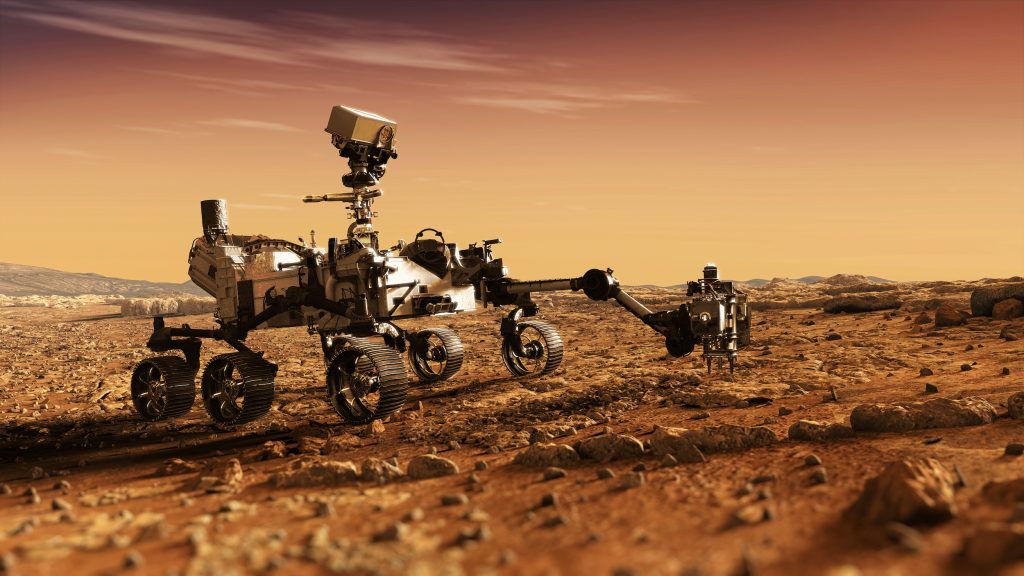The American robotic car Perseverance landed without a hitch on the surface of the planet Mars on February 18th 2021. After a journey of seven months, the Perseverance landed in the Jezero crater on Mars, which scientists suspect was once a lake. The one-tonne-plus Mars rover was equipped with no fewer than 23 cameras and numerous instruments to search for traces of life on Mars. We are proud to share with you more background information about the contribution to this project by ALTEN.
The goal of the Mars Exploration Program of NASA is to explore Mars and to provide a continuous flow of scientific information and discovery through a carefully selected series of robotic orbiters, landers and mobile laboratories interconnected by a high-bandwidth Mars/Earth communications network. The science and technology developed through the Mars Exploration Program will enable humans to one day explore the Red Planet.
During 4 years, ALTEN participated in the Assembly, Integration and Optical Test phases of the SuperCam instrument , a major piece of Perseverance equipment that allows to vaporize Martian rocks using a laser and to analyse their chemical composition by spectroscopy. The ALTEN consultants involved had the mission to verify the proper integration of the optical and electrical elements in the instrument (mirrors, lenses, laser, proximity electronics), to check the proper alignment of the different optical paths and to validate the performance in various environments (clean room, thermal vacuum, vibrations, shocks). The thermal vacuum tests consisted in particular in verifying the good behaviour of the instrument under Martian atmosphere. The instrument underwent temperature cycles, representative of Mars, during which all the performance tests are performed. These tests are determining and require to organize the teams in staggered schedules, in 3×8, 24h, week-ends included.
Most of the SuperCam engineering and testing took place in Toulouse, at the CNES (Centre National d’Études Spatiales) and IRAP (Institut de Recherche en Astrophysique et Planétologie), but the ALTEN consultants also conducted tests in the United States , at Los Alamos National Laboratory and at the Jet Propulsion Laboratory (the famous NASA laboratory!) in order to integrate the instrument on the Perseverance rover and validate its deployment, alignment and performance.
Because on arrival on Mars, ‘SuperCam’ and its mast are maintained against the body of the rover, by a cable, for reasons of clutter that must be minimized in the cap of the launcher. On Mars, a pyrotechnic device is triggered to release and unfold this mast. The tests therefore consisted in verifying that the alignment of the instrument was not disturbed by the waves caused by such a detonation. The ‘SuperCam’ activities took place in a very strict environment of cleanliness and planetary protection, as we did not have to bring our own batteries, microbes, organic particles to Mars. At the height of the activity, up to six ALTEN consultants were involved on the project to cope with the important planning constraints. Of course, they followed the SuperCam landing on Mars live, and will regularly check the performance of the instrument they had in their hands, which is now, on average, 220 million kilometers away from them!

SuperCam, the “eye” of the Martian rover Perseverance
Already in 2012, the NASA Curiosity rover that had just touched down on Mars, had a laser camera called ‘ChemCam’ on board at the top of its mast, to which ALTEN engineers had contributed. A few years later, it was the turn of a new generation of camera called ‘SuperCam’ to be born aboard NASA’s new Perseverance rover, which landed on Mars on February 18, 2021. The result of a French collaboration between CNES and IRAP, SuperCam allows to analyse the rocks and soils of the Red Planet in search of precursor and fossilized signs but also microbial life.
ALTEN’s teams from Assemblage Intégration et Test (AIT) Optique in Toulouse have been working on SuperCam since 2015 and have participated in the integration and qualification of this instrument. In addition to the red laser already present on the Curiosity rover, a green laser with a new wavelength will allow measurements over longer distances, up to 12m (compared to 7m for the red laser), to measure samples the size of a grain of rice. This laser technology nicknamed ‘LIB’ (Laser Induced Breakdown Spectroscopy) allows the analysis of rocks via laser-induced plasma atomic emission spectrometry. A true concentrate of technology, ‘SuperCam’ integrates a more powerful system of high-resolution color imaging called ‘RMI’ (Remote Micro-Imager) and capable of analysing details of 100 microns. The new generation camera of the Rover Perseverance thus allows to exceed the previous technological challenges of the ChemCam camera onboard the Curiosity rover. Objective: more precision, laser analysis over longer distances and the study of living organisms.
Are you interested in following the activities on Mars? Then check out the NASA website, which has many interesting videos, photos and back ground information about this challenging project.
Images: NASA/JPL-Caltech – Sources: NASA / ALTEN Group













